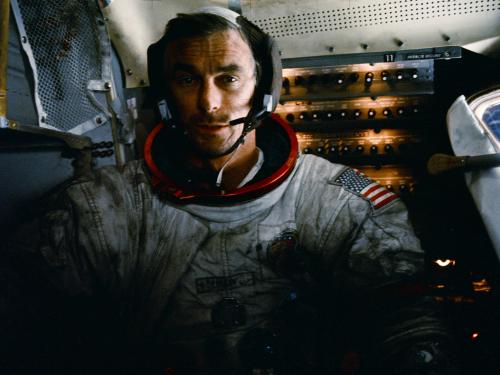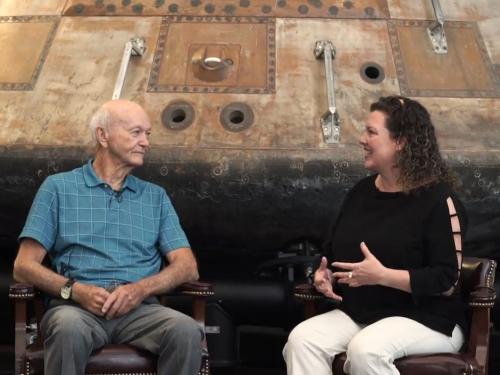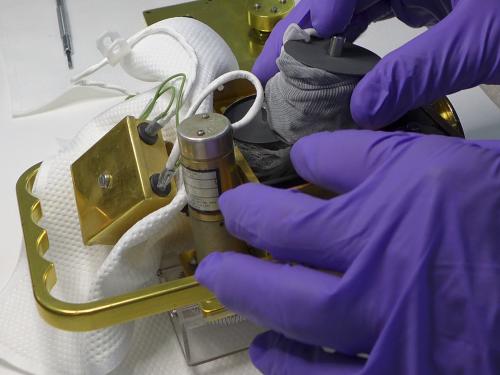
Stories of daring, stories of technological feats, stories of prevailing against the odds ... these are the stories we tell at the National Air and Space Museum. Dive in to the stories below to discover, learn, and be inspired.
Showing 111 - 120 of 176

January 27, 2017
Following the Apollo 1 fire, James Webb, the administrator of NASA, asked President Johnson to conduct an investigation of the tragedy. Johnson agreed and an independent review board was convened. Among the six factors found to contribute to the Apollo 1 fire, one was the lack of a quickly removable hatch. Curator Allan Needell uses hatches from the Museum’s collection to illustrate the changes that were made to the hatch system following Apollo 1 to improve safety.

January 19, 2017
Captain Eugene Andrew Cernan died Monday, surrounded by his family in Houston, Texas. He was 82 years old. For more than half his life, he was known as the Last Man on the Moon, but he was also a devoted father and husband, a naval aviator and advocate, and a great friend to many. He remains a hero for the ages.

January 17, 2017
“Gene” Cernan will always be remembered as the “last man on the Moon”—at least until the next person walks there. As commander of Apollo 17, the final expedition of that program, he spent three days on the Moon with Harrison “Jack” Schmitt. Yet that is not all he accomplished in a storied astronaut career.

December 23, 2016
This week the Apollo 11 Command Module, Columbia, which carried Neil Armstrong, Buzz Aldrin, and Michael Collins on their historic trip to the Moon, moved to the Steven F. Udvar-Hazy Center in Chantilly, Virginia. To many of us at the Museum, the move seemed to have miraculously happened overnight. In truth, the move took a team of experts and months of meticulous planning to pull off.
“This is something that’s unlike anything, at least for me, that I’ve ever moved,” said Anthony Wallace, a museum specialist in the Museum’s collections processing unit. Wallace explained that the spacecraft was not as complicated to move as some of the Museum’s aircraft, but the historical significance of the object heightened everyone’s awareness.

October 07, 2016
Blue Origin, Jeff Bezo’s private rocket company, passed an in-flight test of its launch escape system Wednesday—a method of detaching a crew capsule from a launch rocket. The successful test moves Blue Origin one step closer to its goal of carrying tourists into space.
How to bring crews safely back to Earth in the event something goes wrong during a launch has always been a concern. Launch escape systems have been engineered into nearly all ventures into space.

September 20, 2016
At the Museum we’re fortunate to host many of the nation’s aerospace icons. This was certainly the case earlier this year when Gemini 10 and Apollo 11 astronaut Michael Collins was on hand for our 2016 John H. Glenn Lecture, Spaceflight: Then, Now, Next.

September 06, 2016
The Museum periodically performs a thorough, physical check of all our objects. We open panels and cases and closely inspect each object for any sign of deterioration due to light, humidity, vibration, or just the march of time. We always hope there are no surprises. But when conservator Robin O’Hern, gallery inventory coordinator Erin Ober, and their colleagues opened a large chamber in the Apollo to the Moon gallery, they got a shock; an acrid chemical smell.

August 22, 2016
One of the joys of working with an archive is unearthing the unexpected. When an avowed space nerd like me gets the opportunity to spend time in archives as impressive as the Smithsonian, my journey down research road was a bit circuitous. More often than not, I was lured away from my original focus by fascinating finds. Here are a few of my favorites.

August 16, 2016
Harrison “Jack” Schmitt was the first and last geologist to visit the Moon. Below is his secret chili recipe, served best with a side of tortilla chips and some space history. We can’t help with the chips, but we can tell you a little about this chili-making astronaut.

August 13, 2016
Many are familiar with images of Neil Armstrong and Buzz Aldrin standing beside the Lunar Module (LM) Eagle during the historic Apollo 11 Moon landing. The story of how the LM was developed and tested is a little less familiar. Here are six highlights from a recent talk.